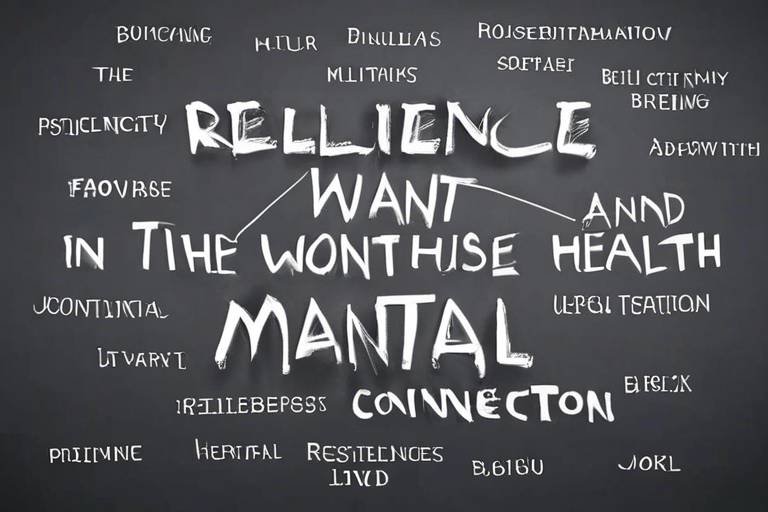How to Nurture Resilience in Difficult Times?
Life is a rollercoaster, isn't it? One moment you're soaring high, and the next, you're plunged into a deep valley of challenges and setbacks. But what if I told you that the key to navigating these turbulent times lies in resilience? Resilience is not just a buzzword; it's a powerful trait that allows us to bounce back from adversity, learn from our experiences, and emerge even stronger. In this article, we will explore effective strategies and techniques that can help you nurture resilience, enabling you to cope better during difficult times.
Understanding resilience is the first step. At its core, resilience is the ability to recover from difficulties and adapt to challenging situations. It's like being a rubber band; you can stretch and bend, but you always return to your original shape. It's not about avoiding stress or hardship; rather, it's about developing the mental fortitude to face these challenges head-on and come out on the other side with newfound strength.
So, why is resilience so important? Think of it this way: when life throws you a curveball, having resilience is like having a safety net. It allows you to take risks, make mistakes, and learn from them without the fear of falling apart. This ability to withstand the storms of life is crucial not only for your mental health but also for your overall well-being. Cultivating resilience can lead to improved relationships, better decision-making, and a more fulfilling life.
Now, let's dive into some practical strategies to nurture resilience. One of the most significant factors influencing resilience is your mindset. A positive mindset empowers you to face challenges with confidence and determination. When you adopt a growth mindset, you view obstacles as opportunities for growth rather than insurmountable barriers. This shift in perspective can make all the difference in how you approach life's difficulties.
So, how do you cultivate a growth mindset? Here are some practical steps:
- Embrace challenges: Instead of shying away from difficult situations, face them head-on. Each challenge is a chance to grow.
- Learn from failures: Mistakes are not the end; they're stepping stones to success. Analyze what went wrong and how you can improve.
- Seek feedback: Constructive criticism helps you see blind spots and areas for improvement. Don't take it personally; use it to fuel your growth.
Another critical aspect of building resilience is overcoming negative thoughts. We all have that inner critic that loves to remind us of our shortcomings. But guess what? You can challenge that voice! Techniques such as cognitive restructuring can help you identify and combat negative self-talk, fostering a more constructive internal dialogue. Instead of saying, "I can't do this," try shifting your perspective to, "I can learn how to do this." This simple change can significantly enhance your resilience.
Setting realistic goals is also essential for nurturing resilience. When you establish achievable objectives, you create a roadmap for success that can enhance your motivation. Think of your goals as stepping stones; each one you achieve builds your confidence and propels you forward. Start small and gradually increase the complexity of your goals as you build momentum.
In addition to mindset and goal-setting, building a strong support network is vital. Surrounding yourself with supportive individuals can make a world of difference during tough times. These connections provide encouragement, understanding, and a sense of belonging. Whether it's friends, family, or support groups, having people to lean on can help you navigate the stormy seas of life.
Last but certainly not least, let's talk about self-care. Taking care of your physical, emotional, and mental health is essential for maintaining resilience. Consider incorporating practices such as mindfulness and meditation into your daily routine. These techniques can help you stay grounded, reduce stress, and enhance your overall well-being.
Regular physical activity and proper nutrition also play a significant role in building resilience. Think of your body as a car; it needs the right fuel and maintenance to run smoothly. Exercise releases endorphins, which boost your mood and reduce stress. Eating a balanced diet ensures that your body has the nutrients it needs to function optimally.
In conclusion, nurturing resilience during difficult times is not only possible but essential for leading a fulfilling life. By understanding resilience, cultivating a positive mindset, building a support network, and practicing self-care, you can develop the tools needed to face life's challenges with confidence and grace. Remember, resilience is like a muscle; the more you work on it, the stronger it becomes. So, embrace the journey, learn from your experiences, and watch as you grow stronger through adversity.
- What is resilience?
Resilience is the ability to bounce back from setbacks and adapt to difficult circumstances. - How can I build resilience?
Building resilience involves developing a positive mindset, setting realistic goals, and maintaining strong social connections. - Why is self-care important for resilience?
Self-care helps maintain physical, emotional, and mental health, which are crucial for coping with stress and adversity.

Understanding Resilience
This article explores effective strategies and techniques to build resilience during challenging periods, helping individuals cope better and emerge stronger from adversity.
Resilience is more than just a buzzword; it’s a vital life skill that enables us to navigate through life’s storms. Think of it as your mental rubber band; the more you stretch it, the stronger it becomes. When faced with adversity, resilient individuals don’t just bounce back—they often come back even stronger than before. But what exactly is resilience, and why is it so important?
At its core, resilience is defined as the ability to recover from setbacks, adapt well to change, and keep going in the face of adversity. It’s the inner strength that helps you rise above challenges and continue moving forward, even when the going gets tough. Imagine a tree bending in the wind; it may sway and lose some leaves, but it stands tall and continues to grow. This is what resilience is all about.
Understanding the importance of resilience is crucial, especially in our fast-paced, often unpredictable world. Life is full of ups and downs, and while we can’t control everything that happens to us, we can control how we respond. Resilience equips us with the tools to handle stress, overcome obstacles, and maintain a sense of purpose. It’s like having a mental toolkit—filled with strategies and techniques—that you can rely on when life throws you a curveball.
Moreover, resilience can be cultivated in everyday life. It’s not just an inherent trait; it’s a skill that can be developed through practice and experience. Here are some key aspects that contribute to building resilience:
- Self-awareness: Knowing your emotions and triggers allows you to navigate through them effectively.
- Emotional regulation: The ability to manage your emotions helps in maintaining balance during tough times.
- Problem-solving skills: Developing strategies to tackle challenges can empower you to face difficulties head-on.
- Social support: Surrounding yourself with supportive people can provide the encouragement needed to persevere.
In summary, resilience is an essential component of our emotional and mental well-being. It allows us to face challenges with courage and determination, ultimately leading to personal growth. As we delve deeper into the strategies for cultivating resilience, remember that it’s a journey, not a destination. Each step you take towards building your resilience is a step towards a stronger, more adaptable you.
A positive mindset is crucial for resilience. Here, we discuss how adopting a growth mindset can empower individuals to face challenges with confidence and determination.
This subsection outlines practical steps to develop a growth mindset, emphasizing the importance of embracing challenges and learning from failures.
Negative self-talk can hinder resilience. This section provides techniques to identify and combat these thoughts, fostering a more constructive internal dialogue.
Setting achievable goals can enhance motivation. Here, we explore how to establish realistic objectives that encourage progress and build confidence.
Social connections are vital for resilience. This section highlights the importance of surrounding oneself with supportive individuals who provide encouragement and understanding during tough times.
Self-care is essential for maintaining resilience. This section discusses various self-care strategies, including physical, emotional, and mental health practices that promote well-being.
Mindfulness practices can enhance resilience by reducing stress. Here, we explore techniques such as meditation and deep breathing that help individuals stay grounded.
Regular exercise and proper nutrition significantly impact resilience. This section examines how physical health contributes to emotional strength and overall well-being.
Q: What is resilience?
A: Resilience is the ability to recover from setbacks and adapt to difficult situations, allowing individuals to bounce back stronger.
Q: Can resilience be learned?
A: Yes, resilience is a skill that can be developed through practice, self-awareness, and supportive relationships.
Q: Why is a growth mindset important for resilience?
A: A growth mindset encourages individuals to embrace challenges and view failures as opportunities for learning, which enhances resilience.
Q: How can I build a support network?
A: Building a support network involves surrounding yourself with positive, understanding individuals who encourage your growth and resilience.

The Role of Mindset
This article explores effective strategies and techniques to build resilience during challenging periods, helping individuals cope better and emerge stronger from adversity.
Resilience is the ability to bounce back from setbacks. This section delves into its definition, importance, and how it can be cultivated in everyday life.
A positive mindset is crucial for resilience. Think of your mindset as the lens through which you view the world; it can either enhance your ability to cope with difficulties or make them feel insurmountable. When faced with challenges, individuals with a constructive mindset are more likely to see obstacles as opportunities for growth rather than as roadblocks. This shift in perception is not just a mental exercise—it's a powerful tool that can transform your reactions to stress and adversity.
So, how can adopting a growth mindset empower you to face challenges with confidence and determination? It's all about perspective. People with a growth mindset believe that their abilities and intelligence can be developed through dedication and hard work. This belief fosters a love for learning and resilience that is essential for great accomplishments. In contrast, those with a fixed mindset often feel threatened by challenges, leading to a fear of failure that can paralyze their progress.
To cultivate a growth mindset, consider these practical steps:
- Embrace Challenges: Instead of avoiding difficult tasks, lean into them. Every challenge is a chance to learn something new.
- Learn from Criticism: View constructive criticism as a valuable feedback tool rather than a personal attack.
- Celebrate Effort: Recognize that effort is a key component of success. Celebrate your hard work, regardless of the outcome.
By integrating these practices into your daily life, you can foster a mindset that not only accepts challenges but actively seeks them out as a pathway to personal growth.
Negative self-talk can be one of the biggest obstacles to resilience. When faced with adversity, it's easy to fall into the trap of thinking, "I can't do this," or "I'm not good enough." These thoughts can create a cycle of self-doubt that undermines your confidence. To combat this, start by identifying these negative thoughts as they arise. Once you recognize them, challenge their validity. Ask yourself questions like, "Is this thought based on fact?" or "What would I tell a friend in this situation?" By reframing these thoughts, you can foster a more constructive internal dialogue, paving the way for resilience.
Setting achievable goals is another powerful strategy for enhancing motivation and building resilience. When you set realistic objectives, you create a roadmap for success that encourages progress. Start by breaking larger goals into smaller, manageable tasks. For example, if your goal is to improve your physical health, you might set weekly targets for exercise or nutrition. This not only makes your goals feel attainable but also provides a sense of accomplishment as you check them off your list. Remember, each small victory builds your confidence and reinforces your ability to overcome challenges.
Social connections are vital for resilience. Surrounding yourself with supportive individuals who provide encouragement and understanding during tough times can make a world of difference. Think of your support network as your personal cheerleading squad—people who lift you up when you're feeling down. They can offer different perspectives, share their own experiences, and remind you that you're not alone in your struggles. Building these connections takes time, but investing in relationships can significantly enhance your resilience.
Self-care is essential for maintaining resilience. This section discusses various self-care strategies, including physical, emotional, and mental health practices that promote well-being.
Mindfulness practices can enhance resilience by reducing stress. Here, we explore techniques such as meditation and deep breathing that help individuals stay grounded.
Regular exercise and proper nutrition significantly impact resilience. This section examines how physical health contributes to emotional strength and overall well-being.
Q: What is resilience?
A: Resilience is the ability to recover from setbacks and adapt well to change and adversity.
Q: How can I develop a growth mindset?
A: You can develop a growth mindset by embracing challenges, learning from criticism, and celebrating effort over results.
Q: Why is a support network important?
A: A support network provides emotional support, different perspectives, and encouragement during tough times, which can enhance resilience.

Cultivating a Growth Mindset
Developing a growth mindset is like planting a seed and nurturing it to grow into a robust tree. It’s about believing that your abilities and intelligence can be developed through dedication and hard work. This perspective is essential, especially during challenging times when setbacks can feel overwhelming. So, how do we cultivate this mindset? Let’s dive into some practical steps that can help you embrace challenges and learn from failures.
First and foremost, it’s important to embrace challenges. Instead of shying away from difficult situations, view them as opportunities to learn and grow. When you encounter a challenge, ask yourself, “What can I learn from this experience?” This shift in perspective can transform obstacles into stepping stones toward success. Remember, every setback is a setup for a comeback!
Next, it's crucial to celebrate effort over outcome. Often, we focus too much on the end result, forgetting that the journey itself is what shapes us. When you put in the effort, regardless of the outcome, acknowledge that hard work. This reinforces the idea that effort is valuable and that it’s okay to fail as long as you’re learning along the way. For instance, if you’re studying for an exam, focus on the time and energy you invested rather than just the grade you receive.
Another key aspect is to seek feedback. Constructive criticism is a powerful tool for growth. Instead of feeling defensive when receiving feedback, view it as a gift that can help you improve. Ask yourself, “How can I use this information to become better?” This approach not only enhances your skills but also builds your resilience by teaching you to handle criticism positively.
Additionally, it’s vital to surround yourself with growth-minded individuals. The people you associate with can significantly influence your mindset. Engage with those who inspire you, challenge you, and support your growth journey. Their positive energy and perspectives can help reinforce your own growth mindset, making it easier to persevere when times get tough.
Lastly, practice self-compassion. Understand that everyone makes mistakes and faces setbacks. Instead of beating yourself up, treat yourself with kindness and understanding. Acknowledge your feelings and remind yourself that you’re on a journey of growth, just like everyone else. This self-compassion can help you bounce back more quickly from failures, allowing you to maintain a positive outlook.
In summary, cultivating a growth mindset is a continuous journey that requires intention and practice. By embracing challenges, celebrating effort, seeking feedback, surrounding yourself with positive influences, and practicing self-compassion, you can foster a mindset that not only helps you weather the storms of life but also propels you toward greater achievements. Remember, every great success story begins with the courage to grow!
- What is a growth mindset? A growth mindset is the belief that abilities and intelligence can be developed through hard work and dedication.
- How can I develop a growth mindset? You can develop a growth mindset by embracing challenges, celebrating effort, seeking feedback, surrounding yourself with supportive people, and practicing self-compassion.
- Why is a growth mindset important? A growth mindset is important because it helps you overcome obstacles and fosters resilience, allowing you to learn from failures and achieve greater success.

Overcoming Negative Thoughts
Negative self-talk can be a sneaky thief, robbing you of your confidence and resilience. It creeps in during the most vulnerable moments, whispering doubts that can feel overwhelming. But here's the good news: you have the power to challenge and change these thoughts! Recognizing that these negative patterns exist is the first step in reclaiming your mental space. Just like weeds in a garden, if left unchecked, they can take over, but with some effort, you can cultivate a flourishing mindset.
One effective technique is to practice cognitive restructuring. This involves identifying negative thoughts and reframing them into a more positive light. For instance, if you catch yourself thinking, “I’ll never get through this,” try flipping it to, “This is tough, but I have faced challenges before and can do it again.” It’s about transforming that internal dialogue into something that empowers rather than diminishes you.
Another method to combat negative thoughts is through mindfulness. This practice encourages you to stay present and observe your thoughts without judgment. When negative thoughts arise, instead of engaging with them, acknowledge their presence and let them pass like clouds drifting across the sky. This can help you detach from the negativity and reduce its impact on your mood.
Additionally, maintaining a gratitude journal can serve as a powerful antidote to negative thinking. Each day, jot down three things you’re grateful for, no matter how small. This simple act shifts your focus from what’s going wrong to what’s going right, gradually training your mind to recognize positivity in your life. Over time, this practice can significantly alter your perspective and enhance your resilience.
It’s also important to surround yourself with positive influences. The people we interact with can shape our thoughts and feelings. Engage with those who uplift you, challenge you to think differently, and provide constructive feedback. When you’re in a supportive environment, it becomes easier to combat negativity and foster resilience.
Finally, remember that overcoming negative thoughts is a journey, not a sprint. It's perfectly normal to have off days. What matters is your commitment to keep pushing through and developing healthier thought patterns. Celebrate your progress, no matter how small, and be patient with yourself. After all, building resilience is like constructing a sturdy bridge; it takes time, effort, and a solid foundation to withstand the storms of life.

Setting Realistic Goals
Setting realistic goals is like laying down the stepping stones on your path to resilience. Imagine you're embarking on a hike up a steep mountain; if your goal is to reach the summit without considering your current fitness level, you might find yourself overwhelmed and ready to give up. On the other hand, if you set smaller, achievable goals—like reaching a scenic viewpoint along the way—you'll not only feel a sense of accomplishment but also build the stamina to continue your journey. Realistic goals serve as those checkpoints that keep you motivated and focused, allowing you to celebrate small victories while working towards larger aspirations.
When it comes to setting these goals, it’s crucial to follow a few key principles. First, ensure that your goals are specific. Instead of saying, "I want to be healthier," a more specific goal would be, "I will exercise for 30 minutes, three times a week." This clarity gives you a tangible target to aim for. Next, your goals should be measurable. This means you should be able to track your progress. For instance, if your goal is to read more, you might set a target of reading one book per month. This not only makes your goal more concrete but also allows you to see how far you've come.
Moreover, it’s essential that your goals are achievable. While it’s great to dream big, setting yourself up for failure by aiming for something unattainable can be detrimental to your resilience. Assess your current situation and resources to determine what is realistically possible. Additionally, your goals should be relevant to your overall life objectives. Ask yourself, "Does this goal align with my values and long-term aspirations?" If it doesn’t, it may be time to reassess your priorities.
Finally, your goals should be time-bound. Setting a deadline creates a sense of urgency and helps you stay focused. For example, instead of saying, "I will save money," you could say, "I will save $500 over the next three months." This approach not only gives you a clear timeline but also allows you to break down your goal into smaller, manageable steps.
In conclusion, setting realistic goals is not just about defining what you want to achieve; it’s about creating a roadmap that guides you through challenges and helps you build resilience. By making your goals specific, measurable, achievable, relevant, and time-bound, you can cultivate a sense of purpose and direction in your life. Remember, each small step you take towards your goal is a victory worth celebrating, and these victories will empower you to face whatever life throws your way.

Building a Support Network
When life throws curveballs, having a support network can be your saving grace. Think of it as your personal safety net—those friends, family members, and colleagues who catch you when you stumble and help you rise again. Building a support network is not just about having people around; it's about cultivating relationships that empower you to navigate through tough times with strength and grace.
First and foremost, it's essential to recognize that not all relationships are created equal. Some people uplift you, while others might drain your energy. Therefore, focus on surrounding yourself with individuals who genuinely care about your well-being and encourage your growth. This could mean spending more time with that friend who always has your back or reaching out to a mentor who inspires you to push your limits.
Moreover, communication plays a pivotal role in nurturing these connections. Don’t hesitate to express your feelings and share your struggles with your support system. This openness fosters deeper bonds and allows others to understand how they can best support you. It's like having your own cheerleading squad—when you share your challenges, they can rally around you, offering advice, a listening ear, or even just a comforting presence.
Another critical aspect of building a support network is to actively engage in community or group activities. Whether it's joining a local club, participating in a class, or volunteering, these environments are fantastic for meeting new people who share similar interests. You never know when a simple conversation can blossom into a meaningful friendship. Plus, being part of a community can provide a sense of belonging, which is crucial during difficult times.
Here’s a quick rundown of some effective ways to build and maintain your support network:
- Stay Connected: Regularly check in with friends and family, even if it's just a quick text or call.
- Be Open: Share your thoughts and feelings; vulnerability can strengthen relationships.
- Offer Support: Be there for others; it creates a reciprocal relationship.
- Join Groups: Find local or online groups that align with your interests.
Lastly, remember that building a support network is an ongoing process. Relationships take time to develop and require effort to maintain. Just like a garden, your support network needs regular attention—water it with kindness, nurture it with communication, and watch it flourish. As you cultivate these connections, you'll find that resilience becomes easier to achieve, and facing life's challenges feels less daunting.
Q1: How do I know if someone is a good fit for my support network?
A1: Look for individuals who uplift you, listen without judgment, and provide constructive feedback. A good support network should feel safe and encouraging.
Q2: What if I feel isolated and struggle to find supportive people?
A2: Consider joining clubs, attending workshops, or engaging in community service. These activities can help you meet like-minded individuals who may become part of your support network.
Q3: How often should I communicate with my support network?
A3: Regular communication is key. Aim to check in with your support network at least once a week, but adjust based on your needs and their availability.

Practicing Self-Care
Self-care is not just a buzzword; it’s a vital practice that helps maintain our resilience during tough times. In the whirlwind of life, we often forget to take a step back and check in with ourselves. Imagine your body and mind as a car; if you don’t take the time to refuel and perform regular maintenance, it’s bound to break down when you need it most! By incorporating self-care into our daily routines, we can enhance our emotional, mental, and physical health, allowing us to face challenges with greater strength and clarity.
One of the most effective self-care strategies is to establish a routine that prioritizes your well-being. This can include simple practices like getting enough sleep, eating nutritious meals, and engaging in regular physical activity. Quality sleep rejuvenates the mind and body, while a balanced diet fuels our energy levels and mood. When we feel good physically, it’s easier to tackle life’s hurdles. Additionally, incorporating exercise into your routine can be a game-changer. It doesn’t have to be intense; even a daily walk can significantly boost your mood and resilience.
Moreover, emotional self-care is equally important. This involves recognizing your feelings and allowing yourself to experience them without judgment. Journaling, for instance, can be a powerful tool for processing emotions. By writing down your thoughts, you can gain clarity and perspective, helping you to navigate through difficult times. Another aspect of emotional self-care is to practice mindfulness and meditation. These techniques not only reduce stress but also enhance your ability to stay present, keeping you grounded amidst chaos.
Let’s not forget about the importance of social connections in our self-care journey. Surrounding yourself with supportive friends and family can provide a significant boost to your resilience. It’s essential to reach out and share your feelings with those who understand and care about you. Having a solid support network can make a world of difference when you’re facing challenges. Remember, you don’t have to go through tough times alone!
To illustrate the various aspects of self-care, here’s a quick overview of some self-care practices you might consider:
| Type of Self-Care | Examples |
|---|---|
| Physical | Regular exercise, balanced nutrition, adequate sleep |
| Emotional | Journaling, mindfulness, talking to friends |
| Mental | Reading, puzzles, learning new skills |
| Spiritual | Meditation, nature walks, yoga |
Ultimately, practicing self-care is about finding what works for you. It’s a personal journey that requires some trial and error. Don’t be afraid to experiment with different techniques until you discover what helps you feel balanced and resilient. Remember, self-care is not selfish; it’s a necessary investment in your well-being. So, take a moment today to acknowledge your needs and prioritize yourself. After all, you can’t pour from an empty cup!
- What is self-care? Self-care refers to the activities and practices that we engage in to maintain our physical, mental, and emotional health.
- Why is self-care important for resilience? Self-care helps replenish our energy and emotional resources, making it easier to cope with stress and adversity.
- How can I incorporate self-care into my daily routine? Start small by setting aside time each day for activities that promote your well-being, such as exercise, meditation, or simply enjoying a hobby.
- Is self-care the same for everyone? No, self-care is a personal journey, and what works for one person may not work for another. It's important to find practices that resonate with you.

Mindfulness and Meditation
In today's fast-paced world, where distractions are just a click away, practicing mindfulness and meditation has become more crucial than ever. These practices not only help in reducing stress but also play a significant role in building resilience. Imagine your mind as a garden; without regular care, it can become overrun with weeds of anxiety and negative thoughts. Mindfulness acts as the gardener, helping you cultivate a peaceful and focused mindset. By being present in the moment, you can better navigate through life's challenges, much like a ship sailing smoothly through a storm.
Mindfulness is all about awareness. It's about noticing your thoughts, feelings, and sensations without judgment. When you practice mindfulness, you train your brain to focus on the here and now, rather than getting lost in worries about the past or future. This shift in focus can lead to a profound sense of calm and clarity, making it easier to cope with stressors. Meditation, on the other hand, is a structured practice that enhances mindfulness. By dedicating a few minutes each day to meditation, you can create a mental space that fosters resilience.
So, how can you incorporate mindfulness and meditation into your daily routine? Here are a few practical techniques:
- Start Small: If you're new to meditation, begin with just five minutes a day. Gradually increase the duration as you become more comfortable.
- Focus on Your Breath: Pay attention to your breathing. Inhale deeply, hold for a moment, and exhale slowly. This simple act can ground you and bring you back to the present.
- Use Guided Meditations: There are numerous apps and online resources available that offer guided meditation sessions. These can be particularly helpful for beginners.
Consistency is key. Just as you wouldn’t expect to build muscle after one workout, developing resilience through mindfulness and meditation takes time and practice. Aim to set aside time each day, even if it’s just a few minutes, to engage in these practices. Over time, you’ll likely notice a shift in your ability to handle stress and adversity. You might find that instead of feeling overwhelmed by challenges, you approach them with a sense of curiosity and calm.
Incorporating mindfulness and meditation into your life is like adding a powerful tool to your resilience toolkit. These practices can help you respond to life's ups and downs with grace and strength. So, take a deep breath, find a quiet space, and embark on this journey of self-discovery and empowerment. Remember, resilience is not about avoiding difficulties; it's about learning to thrive despite them.

Physical Activity and Nutrition
When it comes to building resilience, physical activity and nutrition play crucial roles that often get overlooked. Think of your body as a car; if you don’t fuel it properly and keep it well-maintained, it won’t run efficiently, especially when the road gets bumpy. Engaging in regular exercise not only strengthens your body but also fortifies your mind, helping you to tackle life's challenges more effectively.
Let’s break it down a bit. Regular physical activity releases endorphins, often dubbed as the body’s natural mood lifters. These chemicals act as a natural painkiller and improve your ability to sleep, which in turn reduces stress. Imagine facing a tough day at work after a refreshing run or an invigorating yoga session. You’re likely to feel more energized and ready to conquer whatever comes your way.
But what about nutrition? Well, nutrition is like the high-octane fuel that powers your car. Eating a balanced diet rich in fruits, vegetables, whole grains, and lean proteins can significantly enhance your mood and energy levels. For instance, foods high in omega-3 fatty acids, like salmon and walnuts, have been linked to lower levels of anxiety and depression. It’s like giving your brain a boost, helping you to think clearly and make better decisions during tough times.
To illustrate the importance of nutrition, here’s a simple table that outlines some key nutrients and their benefits for mental resilience:
| Nutrient | Sources | Benefits |
|---|---|---|
| Omega-3 Fatty Acids | Fish, flaxseeds, walnuts | Reduces anxiety, improves mood |
| Antioxidants | Berries, dark chocolate, nuts | Combat stress, protect brain health |
| Vitamin D | Sunlight, fortified foods | Enhances mood, supports immune function |
| Magnesium | Leafy greens, legumes, nuts | Reduces stress, promotes relaxation |
Incorporating physical activity and a balanced diet into your daily routine doesn’t have to be daunting. Start small! Perhaps a brisk 20-minute walk during your lunch break or swapping out sugary snacks for a handful of nuts can make a world of difference. Remember, every little bit counts. The key is consistency. Over time, these small changes accumulate, leading to significant improvements in your overall resilience.
In conclusion, don’t underestimate the power of physical activity and nutrition in your journey to resilience. By treating your body well, you create a strong foundation that supports your mental and emotional health, enabling you to bounce back from setbacks with greater ease. So, what’s stopping you? Start today, and watch how these changes can transform your ability to handle life's challenges!
- How much exercise do I need to do to build resilience? Aim for at least 150 minutes of moderate aerobic activity each week, along with strength training on two or more days.
- Can nutrition really affect my mood? Absolutely! What you eat can have a profound impact on your brain chemistry and overall mood.
- What are some quick and healthy snack options? Consider fruits, nuts, yogurt, or whole-grain crackers as nutritious snacks that can keep your energy up.
Frequently Asked Questions
- What is resilience and why is it important?
Resilience is the ability to bounce back from setbacks and adapt to difficult circumstances. It's crucial because it helps individuals cope with stress, overcome challenges, and emerge stronger from adversity. Think of it as your emotional muscle; the more you exercise it, the stronger it gets!
- How can I develop a growth mindset?
Developing a growth mindset involves embracing challenges, persisting through difficulties, and viewing failures as opportunities to learn. Start by reframing negative thoughts into positive ones, and celebrate small victories along the way. Remember, it's all about progress, not perfection!
- What are some effective ways to combat negative self-talk?
To overcome negative self-talk, try identifying those thoughts and challenging their validity. Replace them with positive affirmations and focus on your strengths. Journaling can also help by allowing you to express and process your feelings, turning the volume down on that inner critic!
- How can setting realistic goals improve my resilience?
Setting realistic goals provides a clear roadmap to success and boosts your motivation. When you achieve these smaller, attainable goals, it builds confidence and encourages you to tackle bigger challenges. It's like climbing a mountain; take it one step at a time!
- Why is having a support network essential for resilience?
A support network offers encouragement, understanding, and shared experiences, which are vital during tough times. Surrounding yourself with positive and supportive individuals can help you navigate challenges more effectively. Think of it as having a safety net when you take risks!
- What self-care practices can help maintain resilience?
Self-care practices such as regular exercise, healthy eating, and mindfulness activities are essential for maintaining resilience. These practices not only enhance physical health but also promote emotional well-being, helping you stay grounded when life gets tough.
- How does mindfulness and meditation contribute to resilience?
Mindfulness and meditation help reduce stress and increase self-awareness, allowing you to respond to challenges with a calm mind. Techniques like deep breathing can ground you in the present moment, making it easier to handle whatever life throws your way.
- What role does physical activity play in building resilience?
Regular physical activity boosts your mood, reduces anxiety, and enhances overall well-being. When you take care of your body, you’re better equipped to handle emotional challenges. It’s like charging your phone; you need to keep it powered up to function well!



















